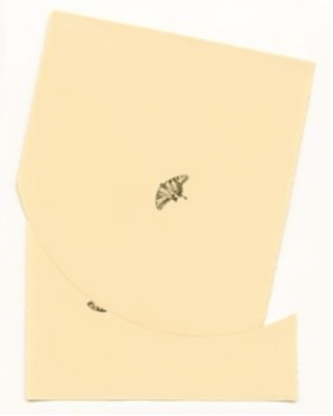
The “paradox” in “Paper Paradox,” a 10-artist exhibit at Carroll Square Gallery, is that the ultimate two-dimensional material can, with some effort, be teased into three-dimensional sculpture. The material for this exhibit is no Dunder-Mifflin overstock product; when the paper in “Paper Paradox” is handmade, even “flat” isn’t flat.
Consider Peter Winant’s “Chalk Lines” (detail at bottom), in which pigment is carefully applied to paper made of abaca and cotton; the resulting buckles on the surface are heightened by the work’s placement in a glassless frame, where it's unrestricted from the viewer.
Or consider Pat Sargent’s “Traces,” which meditates on the artist’s mother through the embedding of partially obscured, cross-hatched portraits in reflective, almost lacquered-looking handmade paper.
Beverly Ress uses rough-textured paper for delicate drawings of birds and butterflies, then carefully cuts and reorients them (at right), suggesting classic Sam Loyd paper puzzles, while Helen Frederick references the elongated female figures of Gustav Klimt, reimagined in flower-patterned rag cotton.
Other artists in the exhibit go so far as to make proper sculptures. Suzanne Desaix’s abstracted “Cornucopia” is constructed from flax, iris, and hay fibers, while Alice Quatrochi’s wall-mounted sculpture is made from flax and wire.
Impressively, and cleverly, Patterson Clark creates urban-themed collages (top) from the unlikeliest of materials: exotic, invasive species that Clark gathers in D.C. and then turns into paper, printing blocks and frames, with ink derived from weed soot. (Full disclosure: Clark, a longtime Washington Post graphic artist, illustrated a number of freelance stories I have written for the Post, though I’ve never met him.)
But the most eloquent (if also fussy) take on paper as art object comes from Ceci Cole McInturff, who has arranged six opened wood boxes in a gentle semicircle, each holding a stack of fragile, translucent, handmade paper inscribed with text, alongside a small, vaguely human sculptural form. The way the paper is stacked—-airily, with varying sizes laying on top of one another—-is a form of sculpture by itself. Though nominally a “book,” this work is more accurately described as carefully constructed treasure boxes, with the humble piece of paper the prize.